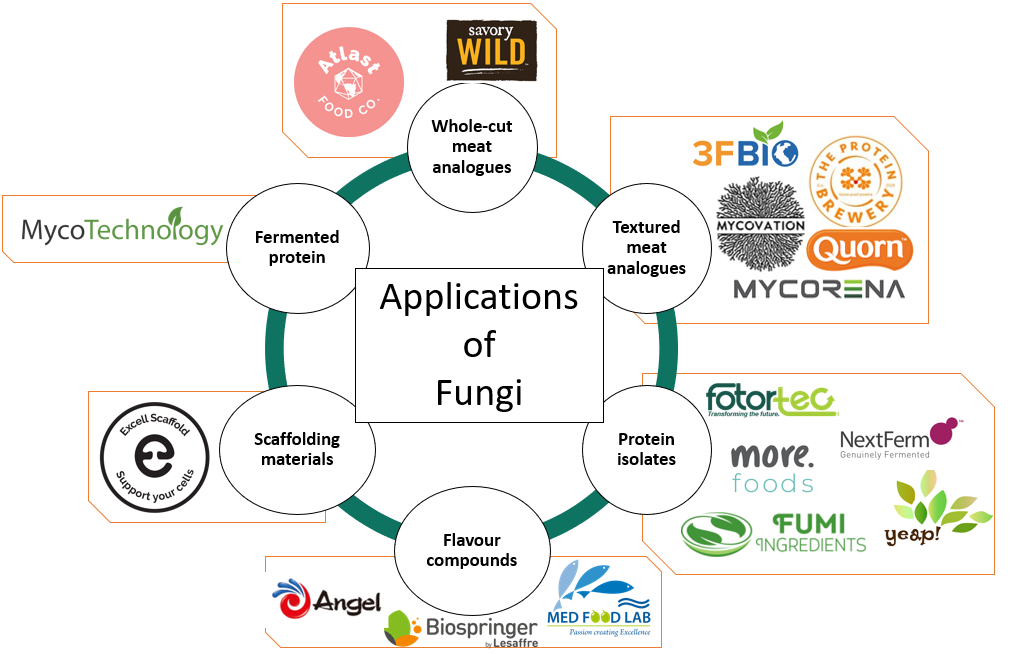
Applications of fungi in the Indian smart protein sector
Alternative protein or smart protein, as we like to call it, paves the way towards feeding India’s growing population without damaging the environment and minimizing stress on depleting land and freshwater sources. While plant-based and cultivated proteins are emerging in India and around the globe, other protein sources like algae, fungi, and other microbes open up possibilities to utilize additional sustainable protein production systems and explore a range of protein functionalities for fermentation-derived meat, egg, and dairy products.
Why are fungi important?
With more than 100,000 species classified as fungi, the genetic diversity of fungi enables various applications of fungi in the alternative protein sector including the creation of textured meat analogues, protein isolates, flavor compounds, scaffolding materials, fermented proteins, whole-cut meat analogues, and growth factors. Microbial species of fungi like yeast and filamentous fungi also provide significant productivity advantages in terms of biomass yield with up to 300 times lower land use and 40 times lower water use per kilo of protein produced, compared to animal-based protein sources. Depending on the species used, fungi contain protein content ranging from 15% to 50% on a dry weight basis, all essential amino acids, high dietary fiber coming from the chitinous cell wall, high vitamin B content, low fat, and no cholesterol. This makes fungi an attractive protein alternative with additional nutritional benefits. Given the efficiency of biomass production, the plethora of applications, and novel nutritional profiles, fungi are emerging as an important source of protein diversification critical for the success of the alternative protein sector in markets such as India. In particular, this emerging area shows promise to create protein self-sufficiency within the context of India and the broader developing world, through decentralized production of nutritious, affordable, sustainable fungal biomass – but not without concerted effort and multi-stakeholder partnerships advancing research and development.
The Good Food Institute India’s mission to accelerate the smart protein sector includes exploring diverse, sustainable protein sources in India and around the globe. Our analysis on the potential of fungi is the second in the series of strategic analyses. With its unique advantage as a global bio-manufacturing hub and biotechnology powerhouse, India can be an industry leader in fungi-based products with the right balance of academic research and entrepreneur-driven innovation coupled with funding from the government, corporate sector, and venture capital firms.
Our report ‘Technological Review of Fungi for Alternative Protein Applications’ is a result of a strategic assessment of the various application areas and analysis of each step of the value chain corresponding to these applications, with the aim to inform stakeholders in the Indian market about pivotal and potentially lucrative interventions required to develop the fungi-derived or fungi-enabled applications.
Methodology
A detailed analysis of each alternative protein application area using fungi was carried out through a literature review. Technological development at each stage of the value chain for each application area was analyzed and various technologies were compared based on qualitative data available in the scientific literature. The analysis was further validated by interviewing industry experts including academicians, entrepreneurs, and companies working on fermentation technologies and fungal applications in the alternative protein sector, both in India and outside India. Recommendations across domains including academic research, industry development, policy, and investment for accelerating the development of the alternative protein application of fungi have been made based on gaps identified by literature review, roundtable discussion with an expert panel, and challenges highlighted by industry experts. The results of this assessment are collated in the form of an ‘opportunities dashboard’ that can be found in an Airtable as you scroll down this webpage.

The report, ‘Technological Review of Fungi for Alternative Protein Applications’, provides an in-depth analysis of the technological development for each application area, an overview of market developments, the regulatory landscape for fungi-derived food products in India, and the talent maturity in India for creating fungi-derived and fungi-enabled alternative protein products.
The opportunities dashboard below is a compilation of relevant interventions corresponding to the challenges in alternative protein applications of fungi. The interventions have been classified based on the application area, the step of the value chain, and the technology domain with an indication of the extent of impact and ease of implementation.
If you would like to contribute to building the fungi enabled alternative protein sector and let us know which intervention interests you the most or if you would like to know more about this space, please write to us at scitech.india@gfi.org with “Alternative protein applications of Fungi” in the subject line.
